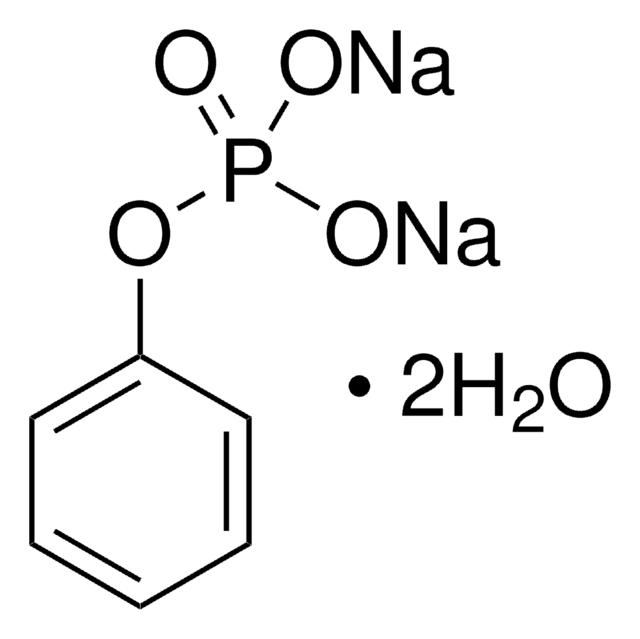P29006
Phenylphosphonic acid
98%
Synonym(s):
Benzene phosphonic acid
Sign Into View Organizational & Contract Pricing
All Photos(4)
About This Item
Linear Formula:
C6H5P(O)(OH)2
CAS Number:
Molecular Weight:
158.09
Beilstein:
2245168
EC Number:
MDL number:
UNSPSC Code:
12352300
PubChem Substance ID:
NACRES:
NA.23
Recommended Products
Assay
98%
form
crystals
mp
162-164 °C (lit.)
SMILES string
OP(O)(=O)c1ccccc1
InChI
1S/C6H7O3P/c7-10(8,9)6-4-2-1-3-5-6/h1-5H,(H2,7,8,9)
InChI key
QLZHNIAADXEJJP-UHFFFAOYSA-N
Looking for similar products? Visit Product Comparison Guide
Related Categories
Application
Additive used with Noyori's catalyst for oxidation of sulfides to sulfones.
Noyori Oxidation (Sodium Tungstate Dihydrate, Hydrogen Peroxide, Methyltri-n-octylammonium Hydrogen Sulfate, Phosphonic Acid)
Noyori Oxidation (Sodium Tungstate Dihydrate, Hydrogen Peroxide, Methyltri-n-octylammonium Hydrogen Sulfate, Phosphonic Acid)
Self assembled monolayers (SAMs)of phenylphosphonic acid may be used to make the interface between organic semiconductors and transparent conductive oxides. The acid may be used to functionalize titania particles. Additive used with Noyorι¢s catalyst for greener oxidation of sulfides to sulfones.
Signal Word
Danger
Hazard Statements
Precautionary Statements
Hazard Classifications
Acute Tox. 4 Oral - Skin Corr. 1B
Storage Class Code
8A - Combustible corrosive hazardous materials
WGK
WGK 3
Flash Point(F)
Not applicable
Flash Point(C)
Not applicable
Personal Protective Equipment
dust mask type N95 (US), Eyeshields, Gloves
Choose from one of the most recent versions:
Already Own This Product?
Find documentation for the products that you have recently purchased in the Document Library.
Customers Also Viewed
K Hendrich et al.
Journal of magnetic resonance. Series B, 105(3), 225-232 (1994-11-01)
Spatial localization with the spectroscopic imaging technique is normally implemented with the Fourier-transform approach, yielding rectangular voxels, with potentially significant cross-voxel contamination. Multidimensional Fourier-series window (FSW) is an alternate approach that generates single voxels of predetermined shape, with minimal out-of-voxel
Zhaohui Cui et al.
Langmuir : the ACS journal of surfaces and colloids, 26(1), 179-182 (2009-08-04)
The in situ crystallization technique has been utilized to fabricate zirconium phenylphosphonate (ZrPP) films with their hexagonal crystallite perpendicular to the copper substrate. The micro/nano roughness surface structure, as well as the intrinsic hydrophobic characteristic of the surface functional groups
Christel Gervais et al.
Magnetic resonance in chemistry : MRC, 42(5), 445-452 (2004-04-20)
1H, 13C, 17O and 31P NMR parameters, including chemical shift tensors and quadrupolar parameters for 17O, were calculated for phenylphosphonic acid, C6H5PO(OH)2, under periodic boundary conditions. The results are in very good agreement with experimental data and permit the unambiguous
M W Fryer et al.
Journal of muscle research and cell motility, 18(2), 161-167 (1997-04-01)
The rate, magnitude and pharmacology of inorganic phosphate (Pi) transport into the sarcoplasmic reticulum were estimated in single, mechanically skinned skeletal muscle fibres of the rat. This was done, indirectly, by using a technique that measured the total Ca2+ content
Jannie P Wijnen et al.
PloS one, 9(7), e102256-e102256 (2014-07-19)
To assess the ability of a polarization transfer (PT) magnetic resonance spectroscopy (MRS) technique to improve the detection of the individual phospholipid metabolites phosphocholine (PC), phosphoethanolamine (PE), glycerophosphocholine (GPC), and glycerophosphoethanolamine (GPE) in vivo in breast tumor xenografts. The adiabatic
Our team of scientists has experience in all areas of research including Life Science, Material Science, Chemical Synthesis, Chromatography, Analytical and many others.
Contact Technical Service













